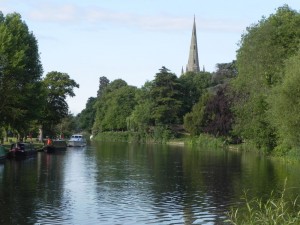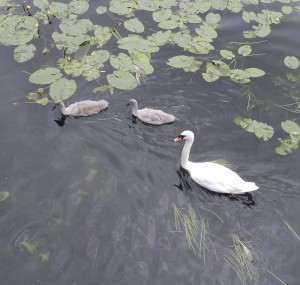The River Avon has always been of central importance to the town of Stratford and the area surrounding it. In Shakespeare’s day, it was an important artery for trade and a source of power (the mill is mentioned in the Domesday Book), but the river also marked an imprecise boundary between two different kinds of countryside. To the north was the well-wooded Forest of Arden, already in decline but still different from the open rolling farmland of the Feldon land to the south. Each type of land would have produced different agricultural goods for exchange in Stratford’s markets. In Shakespeare’s play, King Lear grants his eldest daughters a third of his kingdom:
Of all these bounds, even from this line to this,
With shadowy forests and with champains rich’d,
With plenteous rivers and wide-skirted meads,
We make thee lady.
The river would also have been a magnet for children to swim and play in, and to observe the wildlife. You don’t have to look far in Shakespeare’s plays for evidence of these activities.
Nowadays the river is used entirely for recreation, but even this has its commercial side: you can take a boat trip, hire a rowing boat, or even have dinner on a converted narrow boat. The river links two major sites of Shakespeare importance, the Royal Shakespeare Theatres and Holy Trinity Church.
Among all this the river and its banks are full of life. People walk their dogs, ride bikes, jog, fish, play football, or just stroll. Within a hundred yards of the water there are restaurants, hotels, pubs, car parks, and ice cream vans. In only a little over a mile of its length, four bridges cross the Avon, two carrying traffic and two footbridges.
Yet somehow the river still has a rural feel, helped by the green expanse of the recreation ground opposite the theatres. Walk away from the town in either direction for a few minutes and you find yourself in the countryside. Here the river is calmer, and wildlife has the chance to find quiet pockets to live and breed. It’s surprising how much flourishes here so close to such a busy area.
The cygnets in the photograph are part of a family of swans living near Lucy’s Mill, as are some coot chicks, and there’s another family of swans further up river. Nearer to the centre of town are a few moorhen chicks living cheek by jowl with large numbers of other birds including Canada geese.
In or near to the river I’ve seen quite a range of birds, insects and mammals, most of which are listed at the end of the post. I already mentioned Shakespeare’s interest in wildlife, and Bottom’s song in A Midsummer Night’s Dream includes just a few of the common birds still to be seen here, complete with country names:
The ousel cock (1) so black of hue,
With orange-tawny bill,
The throstle (2) with his note so true,
The wren with little quill.
The finch, the sparrow and the lark,
The plainsong cuckoo grey,
Whose note full many a man doth mark,
And dares not answer “Nay”.
1. Blackbird
2. Thrush
The Avon’s a fragile environment, but an important one, both for the wellbeing of today’s inhabitants and for the heritage of Shakespeare’s town.
A list for wildlife-lovers. On the river: Mute swan, mallard, Canada goose, greylag goose, heron, little grebe, great crested grebe, moorhen, coots, kingfisher. On the banks: song thrush, mistle thrush, starling, robin, wren, blackbird, pigeon, cuckoo, dunnock, swallow, treecreeper, blue tit, great tit, green woodpecker, jackdaw, reed bunting, sedge warbler, whitethroat, goldfinch, greenfinch. Dragonflies, butterflies and squirrels are often seen. Otters are rumoured to pass through and maybe one day I’ll see one!
When the river partially froze last winter we saw kestrel, tufted duck, pochard, black-headed gull and lesser black-backed gull.




What a lovely blog, Sylvia, I feel like heading out for a walk myself now!
Yes thanks for another interesting blog on the importance of the river to the town, you are exactly right about it providing us with nature on our doorstep.
Stratford was a quite a busy inland port, at a time when boats were the only method of transporting goods, then at some point in the 17th century there were plans to increase the size and importance as a port, thankfully unsuccessful. I believe they even wanted to rename the town to New Brunswick? Perhaps Mairi could confirm this?
I wonder what Stratford would have become if this idea had been successful. The only sizeable remnant of the time when the Avon was used for industry is the Cox’s timber yard complex (now a pub/shop/tea room/entertainment venue).
Hello, two weeks ago we sat at the Holiday Inn – where our boats are moored in Stratford upon Avon – having coffee and watching a small flock of Fieldfare’s just outside on the grass and then yesterday 4 Redwing’s. Long-tailed Tits chattering in the trees next to the office and a Kingfisher often sighted perched on the fence. Two swans, Sid & Nancy regularly knock on the office door with their beaks looking for a snack! We’re in the small secluded inlet near the Stratford Marina – what a lovely place to work! If you fancy a walk you can park in the Marina car park & take the footpath upstream – if you’re lucky you might spot the Little Grebe that we catch sight every couple of days. CV37 6YR